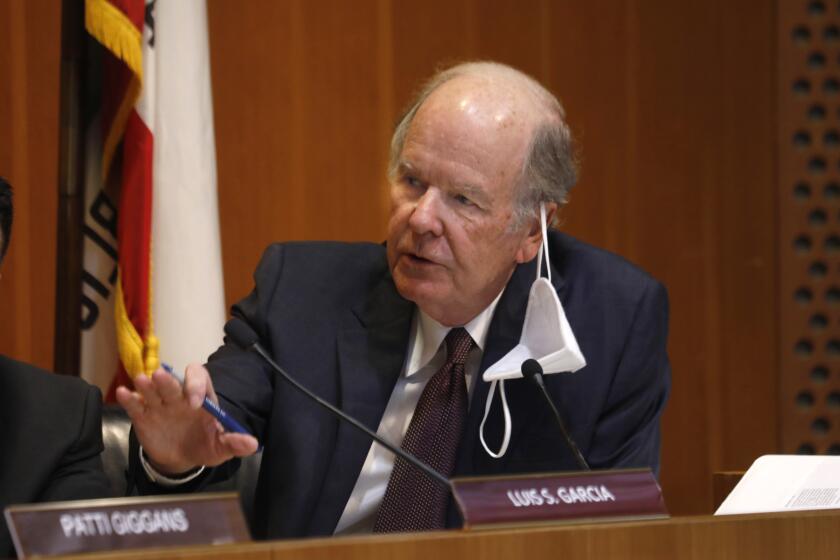Great Read: Creative San Francisco laments death of guerrilla art
- Share via
Reporting From SAN FRANCISCO — Brian Goggin perched on the blue sofa that hung halfway off the roof. He looked down one last time on his guerrilla art masterpiece, “Defenestration,” that had become one of the city’s unlikeliest icons.
More than 17 years ago, Goggin and an army of artists had transformed the four-story, dilapidated building below him by attaching a menagerie of furniture to the sides, creating the illusion of objects being flung into the air.
It was a physical manifestation of the word “defenestration,” which means “a throwing of a person or thing out of a window.”
There was the vintage green refrigerator. The grandfather clock twisted into a slight corkscrew shape. The tables and TV whose bent legs made it appear they were running and leaping. A telephone, swirling lamps, an old radio. Altogether, 34 pieces, including the blue sofa.
Now it was time to take them down. The building is scheduled to be demolished to make way for much-needed affordable housing.
Goggin, 48, donned a hard hat and climbed into the basket of a giant crane that moved him from piece to piece. Using an electric buzz saw and blowtorch, he cut through the metal beams that held the furniture in place, then lowered each piece to the street below. By the end of the day, all but two pieces were down: the sofa and a bathtub that hangs out of a window.
Over the years, the whimsy of “Defenestration” came to symbolize, for many, the city’s prankster spirit and an anarchic, artistic sensibility that fostered the absurd and embraced the desire to make something for its own sake rather than its commercial value.
The demise of “Defenestration” has fed the simmering fear that those same qualities are being driven away as soaring rents and evictions push more artists out of the city. City leaders have become alarmed at the exodus and have launched programs to support artists, particularly those who create public art.
One of those programs funded Goggin’s latest installation hanging from the facade of a luxury apartment building that sits adjacent to Twitter’s headquarters. But the programs weren’t enough to protect “Defenestration,” now that its neighborhood is at last booming because of an influx of tech companies.
Certainly, without “Defenestration,” the city is one building less weird.
“Defenestration would be very difficult to reproduce without the creative community we had back then,” Goggin said. “With everything so expensive, people don’t have as much time to engage in activities that don’t bring in income. And there just aren’t that many abandoned buildings left.”
::
It was March 9, 1997, and all the major freaks turned out to celebrate “Defenestration.”
About 100 volunteers had spent a year helping Goggin build some pieces from scratch and scavenge others, and then attach them to the former Hugo Hotel, a vacant, fire-ravaged structure at 6th and Howard streets in the city’s South of Market neighborhood. When the guerrilla artwork was finished, Goggin celebrated by organizing an Urban Circus and invited just about every faction of the city’s artist community.
The city closed the surrounding streets. Goggin, dressed as a carnival barker with a straw hat and a long, colorful coat, stood on a podium, addressing hundreds of attendees. His thin, wiry frame, handlebar mustache and curly brown hair gave him a mischievous look.
As he spoke, two motorized couches on wheels zipped past carrying riders in outlandish costumes. More than a dozen Santas marched by dressed in red coats and leather pants, some sporting white beards and sashes of bullets draped over their shoulders.
On the side of the building, Warrior Girl, leader of the “Society of Superheroes,” had strung a three-story cobweb. Dressed in red and blue tights, she swung back and forth on a cord attached to the roof battling the “Nation of Finks,” several men wearing bowler hats also swinging from the roof. Whenever they would collide, the crowd would roar and someone standing in one of the windows would hold out a sign that said “Bam!”
Scott Beale, whose “Laughing Squid” Web hosting business supported many of these “starving artists,” said “Defenestration” captured a moment when the city’s art scene was reaching a peak.
“The ‘90s were incredible for San Francisco,” Beale recalled.
It was that freewheeling, chaotic spirit that had drawn Goggin to San Francisco in 1988. A native of Davis, Calif., he had been studying art and English literature in England when he decided to move back to the West Coast.
The abundance of abandoned warehouses and relatively cheap housing gave Goggin the freedom to develop his interest in furniture and urban environments that would eventually blossom into “Defenestration.”
“The city felt much more open at that time,” Goggin said. “There were a lot fewer restrictions on people.”
::
Goggin expected “Defenestration” to last six months.
But the building’s neighborhood remained untouched by developers for years even as gentrification was reshaping much of the city. That changed in 2008, when the city bought the former Hugo Hotel structure and then struck a deal with Mercy Housing, a nonprofit that plans to create 67 units of affordable housing after the building is demolished in September.
Goggin is selling “Defenestration’s” furniture at prices from $650 to $35,000 through Varnish Fine Art gallery to raise money to offset the cost of removing the work and to fund future projects. The blue sofa and bathtub will stay in place until the building is taken down.
“The fact that this is going away is just another cool aspect of San Francisco that’s disappearing,” said Jen Rogers, one of the gallery’s co-owners. “It’s a big bummer.”
Worried that the latest round of gentrification could make it difficult for the city’s creative community to survive, the Board of Supervisors set up an emergency $2-million fund to support arts groups. The supervisors have also expanded the city’s Public Art Trust fund, which requires developers to contribute 1% of the cost of their projects.
It was a $750,000 commission from that public fund that allowed Goggin and Dorka Keehn to create a new public art project: “And My Room Still Rocks Like a Boat on the Sea (Caruso’s Dream).”
The piece consists of 13 glass and steel sculptures shaped like grand pianos with lights pulsing within. The piano sculptures, tethered to a new luxury apartment building, are suspended 25 feet above the sidewalk, as if they had tumbled down.
The name of the installation refers to the opera singer, Enrico Caruso, who was staying at a nearby hotel on the night of San Francisco’s great 1906 earthquake. The piece broadcasts recordings of Caruso singing that can be heard on any radio within 300 feet tuned to 90.9 FM.
On Feb. 23, when “Caruso’s Dream” debuted, Goggin staged another street fair. This time, it featured the Extra Action Marching Band leading a parade of 13 real pianos that were wheeled from the Defenestration building a few blocks away to Goggin’s new work.
As the real grands were played on the street, opera singers performed classical and original music. Three aerialists dressed in red were lowered down the building from the roof to “Caruso’s Dream,” where they swung back and forth removing sails to reveal the glass pianos.
“Without this city,” Goggin said in a speech, “I wouldn’t be able to be the artist that I am.”
::
On a Saturday evening in late May, inside the “Defenestration” building, a small crowd gathered in a dimly lighted room. It was the latest in a series of happenings Goggin has been holding with friends to say goodbye.
Pushed against the walls were the real grand pianos that musician Mauro ffortisimo and Goggin had used months earlier for the unveiling of “Caruso’s Dream.” As the crowd waited for this performance, the talk was of the forces reshaping San Francisco.
“It’s a city that’s changing. But it should be like this,” said Oliver Lowe, who had been part of the “Defenestration” crew. “It should be in flux. And long may it be in flux.”
The show started with Ffortisimo sitting on a stool behind an upright piano with the back cover removed. Using small wooden mallets, he strummed, picked and banged the strings in a loose rhythm. After several minutes, he finished and Goggin took the stage.
“Many people are concerned about this idea that the artwork is coming down and the building will be demolished,” Goggin said. “But instead of being the steward of a piece I made 17 years ago, I’m very interested in doing new work.”
Goggin then read a five-part poem called “Defenestration, an Elegy,” by Toronto-based writer André Alexis. The fifth section is called “The Blue Sofa.”
“I’ve listened to gossip with the abyss,” Goggin read. “I’ve held the void in my arms / and wakened with its imprint on my chest. I’ve sat with endless space / And watched the sky seep into fabric. Times are good, O my city, / But not for us.”
Goggin smiled and looked at the crowd.
“OK, maybe good for some of you.”
Follow @obrien for news about Apple and the Silicon Valley. Email: chris.obrien@latimes.com
More to Read
Sign up for Essential California
The most important California stories and recommendations in your inbox every morning.
You may occasionally receive promotional content from the Los Angeles Times.














